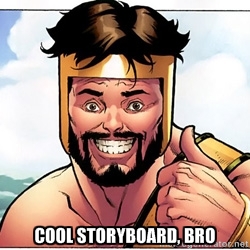This is the post for the Wednesday, April 20, 2016 class meeting.
Mockup and Storyboard Examples
 These examples show the mockups and storyboards that students created for projects in the past:
These examples show the mockups and storyboards that students created for projects in the past:
- Harry Potter Timeline (infographic): Harry Potter Timeline and Mockup using Illustrator
- The Nutcracker Toy Catalog (flipbook/magazine): Remix and Mockup using paper and pen
- Ethereal Ariel (blog): Remix and Mockup using Frame Box
- Scooby-Doo in Retirement: Remix and Mockup using Wireframe (I think?)
- Cat in the Hat Goes College: Remix and Storyboard using PowerPoint
Mockup Tools
Mock-ups are usually used for websites, projects that are “static” (like posters or brochures), and texts that are primarily linguistic or visual in nature. Wireframes (if you’re familiar with the term) fall into this category. Be sure to use the Mock-up guidelines on p. 95 of Writer/Designer to guide your process.
Here are some possible tools:
- Mockflow
- Invision (30-day free trial)
- Frame Box
- Pencil Project
- Wireframe.cc
- iPlotz
- Froont
- Codepen
- Gliffy (a flowcharting tool)
- mindmapping tools (like bubbl.us or Coggle).
Storyboard Tools
Storyboarding is usually used for projects that move through a series of pieces, places, or points in time—like a video, comic book, or graphic novel. Be sure to use the storyboard guidelines on p. 97–98 of Writer/Designer to guide your process.
Storyboarding is, essentially, outlining your text visually, so you may be happy with creating a simple outline in Google Docs. For online tools I’ve made, I created storyboards with PowerPoint and Google Slides as well.
If you want to try something specifically created for storyboarding or a comic making, take at look at these resources for creating and organizing storyboards:
- StoryboardThat
- Storyboard Generator
- Toon Boom Storyboard (30 day trial)
- MakeBeliefsComix
- Pixton
- Bitstrips
Old-Fashioned Tools
Your favorite word processor will work just fine. You don’t need to use fancy tools unless you want to. Microsoft Word or Google Docs tools will give you what you need.
Good, old paper and pencil can work for mock-ups and storyboards. There’s no reason that these planning tools have to be digitally produced.
Backing Up Your Design
Many of the mockup and storyboard tools publish your design on their site. Just in case something goes wrong, I strongly advise you to print your work to a PDF, take a screenshot, or otherwise back up the mockup or storyboard that you create. If you sketch out your mockup or storyboard on paper, take a photo with your phone.
Homework
For Friday, do the following:
- Read Chapter 7 of Writer/Designer. Pay particular attention to the information on rough cuts. You’ll need a rough cut for peer review by 11:59 PM on Tuesday.
- Use the Lynda.com resources in Monday’s post for help with your video, if you’re making one.